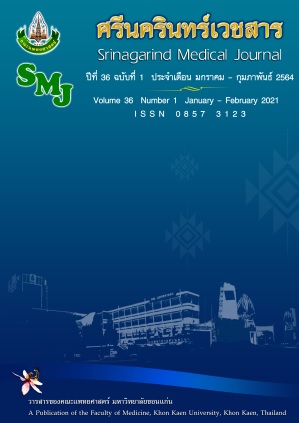Hearing Screening of Newborn at Newborn Intensive Care Unit, Roi Et Hospital
Abstract
การตรวจคัดกรองการได้ยินในทารกแรกเกิดกลุ่มเสี่ยงในหอผู้ป่วยวิกฤตทารกแรกเกิดโรงพยาบาลร้อยเอ็ด
ชัยรัตน์ เสรีรัตน์1 , วิภาดา เสรีรัตน์2
1กลุ่มงานโสต ศอ นาสิก โรงพยาบาลร้อยเอ็ด จังหวัดร้อยเอ็ด
2กลุ่มงานจักษุ โรงพยาบาลร้อยเอ็ด จังหวัดร้อยเอ็ด
บทคัดย่อ
วัตถุประสงค์: เพื่อศึกษาการตรวจคัดกรองการได้ยินในทารกแรกเกิดกลุ่มเสี่ยงในหอผู้ป่วยวิกฤตทารกแรกเกิด
วิธีการศึกษา: รูปแบบการศึกษานี้เป็นแบบ Retrospective study โดยดำเนินการเก็บรวบรวมข้อมูลจากเวชระเบียนผู้ป่วยทารกแรกเกิด 729 รายที่เข้ารับการรักษาในหอผู้ป่วยวิกฤตโรงพยาบาลร้อยเอ็ด ระหว่างวันที่ 1 ตุลาคม พ.ศ. 2556 ถึง 31 กรกฎาคม พ.ศ. 2562 ดำเนินการตรวจคัดกรองการได้ยินด้วยเครื่องวัดเสียงสะท้อนจากหูชั้นในชนิด Distortion-product otoacoustic emissions (DPOAEs) โดยนักตรวจการได้ยินจะใช้เวลาประมาณ 1-2 นาทีต่อหู 1 ข้าง เสียงที่ใช้ในการตรวจจะมีระดับความดังประมาณ 60-70 เดซิเบล ซึ่งไม่เป็นอันตรายต่อหูและการได้ยิน การตรวจวัดเสียงสะท้อนจากหูดำเนินการโดยนักตรวจการได้ยินจะใส่ Probe ที่ช่องหูชั้นนอกของเด็ก จากนั้นจะปล่อยเสียงเข้าไปกระตุ้นและบันทึกผลการตอบสนองของหูชั้นใน เครื่องจะประมวลผลอัตโนมัติ รายงานผลเป็น Pass (ผ่าน) หรือ Refer (ไม่ผ่าน) สถิติที่ใช้ในการวิเคราะห์มูลได้แก่สถิติเชิงพรรณนาและ Chi-square test, Fisher’s Exact test โดยกำหนดระดับนัยสำคัญทางสถิติที่ p <0.05
ผลการศึกษา: ทารกแรกเกิดจำนวน 729 ราย ส่วนใหญ่เป็นเพศชายร้อยละ 59.67 คลอดก่อนกำหนด ร้อยละ 42.25 น้ำหนักแรกคลอดน้อยกว่า 1,500 กรัมร้อยละ 15.09 ผลตรวจคัดกรองการได้ยินผ่าน ทั้งสองข้างร้อยละ 90.53 ไม่ผ่านทั้ง 2 ข้างร้อยละ 4.66 หูขวาไม่ผ่านร้อยละ 1.23 หูซ้ายไม่ผ่านร้อยละ 0.27 ปัจจัยที่มีความสัมพันธ์ต่อการเกิดภาวะสูญเสียการได้ยินในทารกแรกเกิดที่เข้ารับการรักษาในหอผู้ป่วยวิกฤตทารกแรกเกิดได้แก่ Craniofacial anomalies (p=0.001), Ototoxic medication (p=0.019), Low apgar score (p=0.036), On mechanical ventilator (≥7 days) (p=0.011) และ Stigmata associated syndrome to include Sensorineural hearing loss 1 Conductive hearing loss (p=0.026) ผลการคัดกรองการได้ยินพบว่าสามารถคัดกรองทารกได้ร้อยละ 97.07 และมีอัตราการส่งต่อร้อยละ 4.66 อัตราการกลับมาตรวจซ้ำร้อยละ 47.05 ทารกได้รับการวินิจฉัยว่าสูญเสียการได้ยิน 6 ราย ร้อยละ 0.83 ของเด็กที่ได้รับการคัดกรองทั้งหมด ได้รับเครื่องช่วยฟัง 5 ราย และไม่มาตามนัด 1 ราย
สรุป: การศึกษานี้แสดงให้เห็นว่าการตรวจคัดกรองการได้ยินในทารกแรกเกิดกลุ่มเสี่ยงที่เข้ารับการรักษาในหอผู้ป่วยวิกฤตทารกแรกเกิดเป็นสิ่งสำคัญมากซึ่งพบว่าปัจจัยเสี่ยงต่อการเกิดการสูญเสียการได้ยินของทารกแรกเกิดมีหลายปัจจัยซึ่งทารกแรกเกิดที่มีความเสี่ยงต่างๆเหล่านี้ควรได้รับการดูแล เฝ้าระวังและติดตามการรักษาอย่างต่อเนื่องเพาะถ้าหากพบความผิดปกติจะได้ทำการรักษาและฟื้นฟูได้อย่างทันท่วงที
คำสำคัญ: การตรวจคัดกรองการได้ยิน; ทารกแรกเกิด; หอผู้ป่วยวิกฤตทารกแรกเกิด; การสูญเสียการได้ยิน
Abstract
Objective: To study the hearing screening of newborn at Newborn Intensive Care Unit.
Methods: This was a retrospective study, all data were retrieved from medical records of 729 cases at Newborn Intensive Care Unit, Roi Et Hospital during October 1, 2013 to July 31, 2019. The hearing loss screenings were used Distortion-product otoacoustic emissions (DPOAEs) by audiologist took time for 1-2 minutes per ear. The sound used for examination was loudness approximately level 60-70 decibels which was not harmful to ears and hearing of infant. The echo measurement was performed by audiologist by insert probe to outer ear canal of infant. Then released sound to stimulate and record the response of the inner ear. The machine will automatically process and reported the results that Pass or Refer. The statistics used for data analysis were descriptive statistics, Chi-square test and Fisher’s Exact test. The statistical significance was set at p <0.05.
Results: Of 729 infants most of them were male 59.67%, preterm birth 42.25%, birth weight < 1,500 gram 15.09%, hearing screening Pass both ear 90.53%, Refer both ear 4.66%. Right ear Refer 1.23%, Left ear Refer 0.27%. The factors associated with hearing loss of infants in Newborn Intensive Care Unit were Craniofacial anomalies (p=0.001), Ototoxic medication (p=0.019), Low apgar score (p=0.036), On mechanical ventilator (≥7 days) (p=0.011) and Stigmata associated syndrome to include Stigmata associated syndrome to include sensorineural hearing loss 1 conductive hearing loss (p=0.026). Rate of hearing screening was 97.07%, referral rate was 4.66% and follow up rate was 47.05%. Of 6 infants has diagnosed for hearing loss (0.83 %), received hearing aid 5 cases, and loss follow up 1 case.
Conclusion: This study revealed that the hearing loss screening of newborns in high risk group at the Neonatal Intensive Care Unit that very important. It was found out that the risk factors of hearing loss of newborn had several factors. The newborns at risks should be monitored and continuously to treated, if abnormalities were found the treatment and recovery should promptly performed.
Keywords: Hearing screening; newborn; Newborn Intensive Care Unit; Hearing loss


